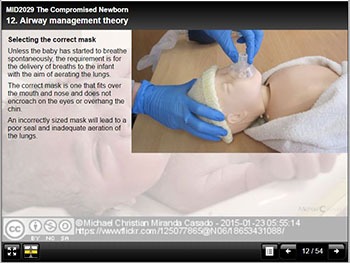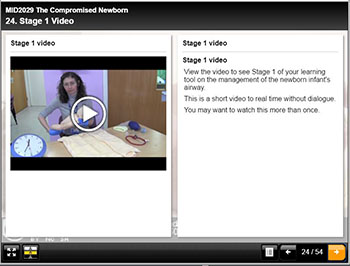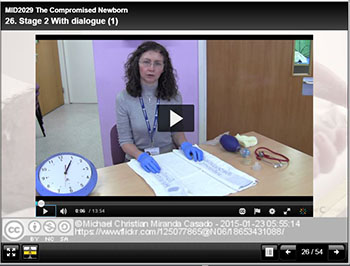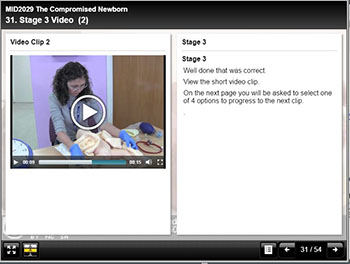Newborn Airway Management e-learning – “Overall this tool was brilliant to aid our learning”
Melanie Cole achieves tremendous praise from her students who undertook their study using the Xerte e-learning package.
Newborn airway skills teaching and learning
Second year student midwives are required to demonstrate knowledge and manual dexterity skills in key elements of newborn resuscitation while undertaking the undergraduate module ‘The Compromised Newborn’. All those responsible for the care of the newborn infant should be able to provide basic assistance including essential airway management to a baby that does not make a normal transition to extra- uterine life.
The ‘4 stage approach’ is a recognised tool to facilitate acquisition of skills in resuscitation of the newborn infant and is advocated by the UK Resuscitation Council (2015).
Stage 1 – a silent demonstration of the skill by the tutor, allows the learner to observe the skill to real time.
Stage 2 – a demonstration with the addition of tutor dialogue, allows deconstruction of the skill and provides rationale for techniques and the structured approach.
Stage 3 – another tutor led demonstration which encourages the learner to verbally predict the next step and provide commentary for the tutor.
Stage 4 allows the learner to perform the skill independently with tutor and peer support.
Planning an online teaching and learning package
With our future learning environment at Waterside and a shift towards blended learning in mind, I explored the prospect of combining video assisted technology with face to face teaching and learning. My aim was to provide Stage 1, 2 and 3 online and bring the students to the university to consolidate learning and practice new skills during scheduled tutor facilitated contact sessions in small groups. While Kaltura enables the students to engage with stages 1 and 2 in viewing pre-recorded demonstrations of the skill, the challenge was related to Stage 3 and in providing an opportunity for students to be able to engage and contribute online. I contacted Anne Misselbrook from the Learning Technology Team and during a meeting we discussed my requirements and vision for the online resource. Anne quickly identified the Xerte learning package as an e-learning tool that would support my needs and enable Stage 1, 2 and 3 to be delivered online.
Creating an online package
Andy Stenhouse helped me to create the video of the skill being performed in real time (Stage 1) and the video of the skill being performed with tutor dialogue (Stage 2). The video of the skill in real time was then spilt into 10 smaller clips to enable Stage 3 to be created. The students would then be able to view a small clip and choose an answer from a multiple choice question to predict what should happen next. A correct answer takes the student to the next clip while an incorrect answer takes them back to the beginning of Stage 3. The student has to answer each question correctly to get to the end of the sequence and they can have as many attempts as they wish, accommodating individual needs and learning styles.
Six months after I contacted the learntech team the final xerte was embedded into NILE within a series of timetabled learning units and was accessed by the pre-registration midwifery students in October 2016.
These are some quotes from the students who engaged in an online survey following uptake of the xerte learning tool:
Positive Comments
“I found this learning tool extremely helpful and it had the perfect mix of written information and pictures/videos. I feel this will really help me in my practical assessment, if you got a question wrong you had to go back to the beginning which I thought was a really good idea as it enabled you to revisit information that you may not have completely took in and allowed you to keep going over it until this information has stuck”.
“I think the xerte learning tool is of great benefit as it enabled me to go through the learning stages at my own pace and I am able to revisit the information as often as I want in preparation for my assessment. I especially found the videos useful and with these found the content easier to understand”.
“I thought it was extremely useful. The videos were excellent. A good variety of media used too which encouraged learning. I found it very helpful”.
“Overall this tool was brilliant to aid our learning and being able to go back to the videos and quizzes will be very helpful before the assessment”.
“I thought the learning tool was excellent and a great help to my understanding of the topic. So much better than reading a book about it”.
“I believe this to be an excellent method of learning, as you can view the correct way to manage the airway and view it as many times as you wish”.
“A really good learning tool. Easy to follow and in order, making it easy to revise and understand”.
“The videos were really good, easy to understand and clear”.
“I felt the videos very useful especially as I believe I am a visual learner”.
Suggestions for modification
“Instead of going back to the beginning when getting an answer wrong, perhaps just show it is the wrong answer and give another opportunity to select correct answer”.
“Having to go right back to the beginning if you had got a question wrong was slightly frustrating although it did make me remember information so there were definite pros and cons to that process”.
Concluding reflection
Anne provided customised training and valuable support throughout the design and implementation phases. Time for early engagement and collaboration between myself and the Learning Technology Team proved to be vital in the planning, configuring and embedding of Xerte into the module. Inputting theory (text and images) is relatively straightforward on Xerte, creating the activity in Stage 3 and embedding the videos was more complex.
I imagine this approach might be suitable for other practical skills based teaching and learning within the university and I would encourage academic colleagues to give it a try with the support of the Learning Technology Team.
Recent Posts
- Blackboard Upgrade – December 2025
- Preparing for your Physiotherapy Apprenticeship Programme (PREP-PAP) by Fiona Barrett and Anna Smith
- Blackboard Upgrade – November 2025
- Fix Your Content Day 2025
- Blackboard Upgrade – October 2025
- Blackboard Upgrade – September 2025
- The potential student benefits of staying engaged with learning and teaching material
- LearnTech Symposium 2025
- Blackboard Upgrade – August 2025
- H5P (HTML5 package) content types meets the needs of Jim Atkinson, Staff Development Trainer
Tags
ABL Practitioner Stories Academic Skills Accessibility Active Blended Learning (ABL) ADE AI Artificial Intelligence Assessment Design Assessment Tools Blackboard Blackboard Learn Blackboard Upgrade Blended Learning Blogs CAIeRO Collaborate Collaboration Distance Learning Feedback FHES Flipped Learning iNorthampton iPad Kaltura Learner Experience MALT Mobile Newsletter NILE NILE Ultra Outside the box Panopto Presentations Quality Reflection SHED Submitting and Grading Electronically (SaGE) Turnitin Ultra Ultra Upgrade Update Updates Video Waterside XerteArchives
Site Admin






